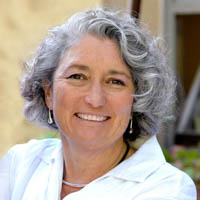This spring marked the one year anniversary of when the coronavirus pandemic forced K-12 schools across California and in other parts of the country to make an unprecedented shift from in-person to remote instruction. Teachers are now wrapping up their second school year affected by the turmoil of a global pandemic, but hopes are mounting for a return to normalcy in the fall. UC Santa Cruz researchers who have studied the pandemic’s impact on K-12 education share lessons they hope will be remembered as we look toward the future.
Redefining success in times of crisis
Lora Bartlett, associate professor of education, leads the Suddenly Distant project, a team of researchers across the country who are studying how COVID-19 has influenced teachers’ work.

Teaching during a pandemic is hard on teachers and students. 78 percent of teachers in our study reported student engagement as a challenge in their classrooms during the fall of 2020, and 57 percent were concerned about unequal access to learning. In most cases, student participation plummeted most drastically among students from lower income households, students with special needs, English language learners, and students who were already struggling academically.
Teachers expressed a need to focus on the social and emotional well-being of students, and they sought to balance curriculum coverage with establishing a connection with students to keep them energized for learning. Initially, education policies sought to support these teaching practices, but as the pandemic dragged on, teachers faced increasing pressure to return to pre-pandemic norms. Our research indicates that policies like premature reinstitution of state standardized testing can erode teachers’ ability to create a supportive learning environment that centers student well-being and engagement during a time of crisis.
Recess as a tool for healing
Rebecca London, associate professor of sociology, studies how elementary schools can use recess to support positive student outcomes.
 COVID-19 is the first collective trauma event that we’ve experienced in decades. Prolonged exposure to this type of stress for children can evoke a range of outcomes—anxiety, impaired memory, problems with mood control, and many other effects. We wouldn’t expect children who have experienced the stress of a pandemic to be able to perform at the same level at school or anywhere else. And we know that children from Black, Latinx, and low-income families have been affected at higher rates. Before we can address “learning loss” at school, we must focus on healing. Through play, the whole school community can heal. Play therapy is a widely-used clinical approach because it’s how children naturally work through their experiences and practice social-emotional skills like self-regulation, cooperation, and self-awareness.
COVID-19 is the first collective trauma event that we’ve experienced in decades. Prolonged exposure to this type of stress for children can evoke a range of outcomes—anxiety, impaired memory, problems with mood control, and many other effects. We wouldn’t expect children who have experienced the stress of a pandemic to be able to perform at the same level at school or anywhere else. And we know that children from Black, Latinx, and low-income families have been affected at higher rates. Before we can address “learning loss” at school, we must focus on healing. Through play, the whole school community can heal. Play therapy is a widely-used clinical approach because it’s how children naturally work through their experiences and practice social-emotional skills like self-regulation, cooperation, and self-awareness.
Play during recess builds relationships between children and between classes and their teachers, which creates a healing environment in schools. Play can also involve physical activity, which boosts attention and cognition, and it often takes place outdoors, which is good for virus control. Adults should monitor and support play to make sure it’s safe, healthy, and inclusive. Withholding recess is the most common punishment for elementary students, and we need to rethink that. Things that look like misbehavior could be natural reactions to stress and trauma, and we don’t want to punish students for that. We also don’t want to cut into playtime as a way to make up instruction time. Play is for healing, and we need to focus on that.
Addressing inequities in mathematics instruction
Judit Moschkovich, professor of education, studies how mathematics instruction can support English learners.
 The inequities in mathematics education that have been previously documented for English learners were likely exacerbated during the pandemic. English learners often have fewer opportunities to engage with high-quality mathematics instruction because of deficit views of these students and systemic issues such as a lack of certified teachers. Common teaching pitfalls include focusing on vocabulary first, treating everyday and home languages as obstacles to learning math, and simplifying math content by focusing on rote memorization. And in my interactions with mathematics educators and researchers across the country, I’ve heard informal reports that the move to online teaching may have created a shift to even more rote instruction.
The inequities in mathematics education that have been previously documented for English learners were likely exacerbated during the pandemic. English learners often have fewer opportunities to engage with high-quality mathematics instruction because of deficit views of these students and systemic issues such as a lack of certified teachers. Common teaching pitfalls include focusing on vocabulary first, treating everyday and home languages as obstacles to learning math, and simplifying math content by focusing on rote memorization. And in my interactions with mathematics educators and researchers across the country, I’ve heard informal reports that the move to online teaching may have created a shift to even more rote instruction.
As schools recover, mathematics instruction will need to refocus on applying the strategies that research has shown are most effective to support English learners in learning mathematics with understanding. Engaging students in mathematical practices like reasoning, explaining, justifying, and conjecturing develops deep mathematical understanding and supports language and content knowledge to develop together. We should also remember that students have been through multiple types of emotional trauma. It is crucial that mathematics instruction not inflict further trauma. This is a sufficient reason to avoid high stakes math tests. Instead of testing to document “all the math I didn’t learn during the pandemic,” teachers can use short assessments at the start of a lesson to check on understanding and progress.
Bridging the digital divide
Cynthia Lewis, professor and chair of the Education Department, is working with Leslie Lopez, director of Corre La Voz, and undergraduate researcher Jesica Garcia and Ph.D. student Mario Gomez-Zomora to understand how community partnerships might enhance online learning.
 The use of digital technologies as primary tools for teaching and learning during the pandemic was a challenge for community organizations that provide educational programming for underserved K-12 Latinx youth and their families. Many of the households served by these programs do not have access to technology or Wi-Fi. This contributes to the digital divide that significantly disadvantages students from low-income households. But our research observed how local nonprofit Senderos partnered with UCSC’s Corre La Voz service learning program, directed by Leslie Lopez—which has a long history of engaging youth through digital media—to make sure that students were able to successfully apply technology resources provided by their schools to develop language and literacy skills.
The use of digital technologies as primary tools for teaching and learning during the pandemic was a challenge for community organizations that provide educational programming for underserved K-12 Latinx youth and their families. Many of the households served by these programs do not have access to technology or Wi-Fi. This contributes to the digital divide that significantly disadvantages students from low-income households. But our research observed how local nonprofit Senderos partnered with UCSC’s Corre La Voz service learning program, directed by Leslie Lopez—which has a long history of engaging youth through digital media—to make sure that students were able to successfully apply technology resources provided by their schools to develop language and literacy skills.
In analyzing interactions among participants in this partnership-based program, we found that the program succeeded in building a sense of community, even in challenging times and through remote teaching and learning. The program provided an online space to be with others who share life experiences, language, and culture. The youth are tuned in and engaged, thinking critically, asking questions, and using their imaginations. Most importantly, they are building confidence and envisioning possible futures. We hope for even stronger ties in the future as we transition to in-person sessions, assess family and youth needs through surveys and interviews, and continue to enhance the partnership.
Translating research into policy
Margarita Azmitia, professor of psychology, collaborated with a network of academics to develop a policy brief with recommendations for mitigating COVID-19’s impacts on education.
 I joined a policy rapid response network with about 200 other scholars to target anti-racist policy issues related to children, adolescents, and their families. The particular group I worked with was focused on the effects of COVID-19 on K-12 students and their families. We were tasked with reviewing the published scholarly literature, media coverage, and reports from the Pew Research Center. We submitted short written suggestions—not more than one paragraph, with citations—to the first authors of the brief, and within a few months, a final product was published and distributed among federal and state policymakers and other stakeholders.
I joined a policy rapid response network with about 200 other scholars to target anti-racist policy issues related to children, adolescents, and their families. The particular group I worked with was focused on the effects of COVID-19 on K-12 students and their families. We were tasked with reviewing the published scholarly literature, media coverage, and reports from the Pew Research Center. We submitted short written suggestions—not more than one paragraph, with citations—to the first authors of the brief, and within a few months, a final product was published and distributed among federal and state policymakers and other stakeholders.
Our group was committed to underscoring the more profound effects of COVID-19 on minoritized low-income families, particularly Latinx people and African Americans. I learned a lot about how to write policy briefs in the process. In scholarly research and writing, we can’t make generalizations. We often are very careful to say “our results depend on x or y,” but you can’t do this in a policy brief because conditional statements will be dismissed. I had to be comfortable with making strong points that may create anti-racist policies on behalf of students and their families. This was not hard because, for 30 years, I have seen first-hand the challenges that minoritized, low-income, immigrant, and undocumented families face in helping their children achieve in school.



